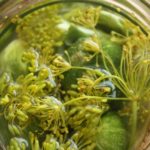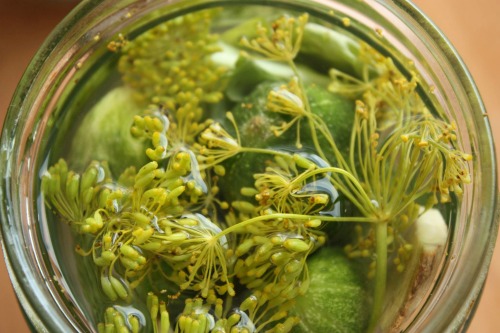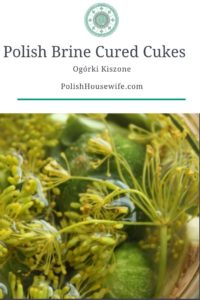I’ve gone all American on you with the title of this post, Polish Pickles. One lesson I learned from my Polish friends was that pickles are made with vinegar. The preferred method of creating sour little cucumbers in Poland is to preserve them in brine, so these are more correctly referred to a preserved cucumbers rather than pickled cucumbers. If this differs from your family’s English definition of Ogórki Kiszone, I’ll have to refer you to my group of experts in Poznan. I’m just repeating what I’ve been told.
Ogórki Kiszone are much loved, and I was fortunate to be given jars of brine-preserved cukes twice. The first jar came from my friend Elzbieta, her mother makes them every year. The second came from a young man, an engineering student at our Poznan’s Politechnika University, and a waiter at our local TGI Fridays.
We would chat at Fridays and occasionally run into each other at a party in our neighborhood. At some point, we got on the subject of Ogórki Kiszone, and the next time I saw him, he brought me a jar of his mother’s preserved cucumbers. Apparently, he had multiple jars stashed in his dorm room. I returned the favor at our next meeting with samples of a few things I’ve been whipping up in the kitchen, almond cookies, and his favorite Bailey’s pinwheels.
One of the things I loved about Polish supermarkets (even little markets) was the pack of veggies they’d put together for soup making and in the summer, for your Ogórki Kiszone. I bought one of these when I tried my hand at this Polish staple in Poznan.
It included multiple cloves of garlic, a flowering stem of dill, a piece of horseradish root, and leaves. My research tells me that any of the following leaves can be used: cherry, black currant, raspberry, oak, grape, horseradish, mustard. The leaves contain tannin and are supposed to help the cucumbers stay crisp during the fermentation process. That’s what’s happening to produce the sour taste, lacto-fermentation.
Laco-fermentation doesn’t involve dairy. Lacto refers to lactic acid. All fruits and vegetables have beneficial bacteria such as Lactobacillus on the surface. In an oxygen-free environment, these bacteria convert sugars into lactic acid, which inhibits harmful bacteria and acts as a preservative. (This is why you want your cucumbers completely submerged, so they’re in an oxygen-free environment.) It’s also what gives fermented foods such as sauerkraut, kombucha, or sourdough bread their characteristic sour flavor.
Below you’ll find the basic process for making one quart of Ogórki Kiszone. Other than the cucumbers and salt, you should feel free to adjust, add to (maybe a bit of chili pepper), or omit on the ingredient list and multiply based on the number of quart jars you’d like to make.
Smacznego!
Lois
PS – Once you’ve preserved your cukes, you’ll want to try making this soup!
Print
Ogorki Kiszone (Polish Pickles)
- Yield: 1 quart 1x
- Cuisine: Polish
Description
Cucumbers, naturally fermented in a flavorful brine
Ingredients
- wide mouth 1 quart jar
- 8 to 10 pickling cucumbers (4–6 inches long), washed and dried
- 2 tablespoons pickling salt or sea salt
- 1 quart water
- 2 teaspoons mustard seeds
- 2 cloves peeled garlic
- 1 stem dill, preferably flowering
- fresh horseradish root, about 1 inch long
- bay leaf
- Cherry, grape, blackcurrant, or oak leaf
Instructions
- Tightly pack the cucumbers into the sterile jar, you want to squeeze them in, so they’ll stay submerged and not float to the top of the liquid
- Add the salt to the water and bring to a boil, cool
- Add the mustard seeds, garlic, dill (fold to fit), horseradish, bay leaf, and other leaf if you have one
- Fill the jar with the salt water to within 1/4 from the top, all of your ingredients should be covered
- Loosely cap the jar with a sterile lid, the lid must be loose to allow the gases produced during fermentation to escape, some brine may seep out, so store where this won’t be a problem
- As it ferments, the brine will become cloudy
- Depending on your taste, the cucumbers will be ready to eat in 1 to 3 weeks
- Fermentation will end after 5-6 weeks, if you have any left at this point, the lids should be tightened to prevent spoilage
An accountant by trade and a food blogger since 2009, Lois Britton fell in love with Polish cuisine during the years she lived in Poznań, Poland. As the creator of PolishHousewife.com, she loves connecting readers with traditional Polish recipes. Lois has a graduate certificate in Food Writing and Photography from the University of South Florida. She is the author of The Polish Housewife Cookbook, available on Amazon and on her website.






Carol Fulgenzi
On your Polish pickle recipe, do you boil the pickles in a water bath? It seems I remember my grandma doing pickles but doing a water bath and that kept them from spoiling. Thanks for the info!
★★★★
polishhousewife
My sources don’t use a water bath in canning, but I can imagine it would provide longer shelf life, but you would give up the probiotics benefits.
Tessa
We just put cucumbers in a bowl and cover with boiling water. Leave for 10 – 15 min. Then drain.
Carolyntobolewsk
How long can they be stored in a cool cupboard once they are sealed tight?
polishhousewife
My Polish friends kept them in the cupboard until they were gone or until the next season.
Jimmy Szczesny
” water bath ” as in processing? No need for brine cured. But if cucumbers are not picked the same day that you can, they should be soaked in cold water for 2-3 hours, washed, dried and scalded in boiling water. Also, be gentle when washing, you want to keep all those little bumps. They just need to be rinsed.
Jimmy Szczesny
Your not going to fit 8 to 10, 4 inch pickles, in a 1 quart jar, unless maybe you slice then.
Gloria
How long is the shelf life after they have fully fermented? And, should they be refrigerated after fermented?
polishhousewife
After fermentation has stopped and the lids have been tightened, they can be kept on the shelf for a year. After opening a jar, I would keep in in the fridge, for up to a month.
The acidity produced by fermentation, the salt added and the fact that the cukes are submerged in the solution prevent undesired bacteria from growing.
Sauerkraut Billy
Thanks so much for the recipe Lois! Super excited to try these polish pickles and make them at home. Next time I head out to the market i’ll definitely have to grab up the ingredients to make this! I’ll report back with how everything goes. I’ve never added horseradish to a pickling before! Thanks again!
★★★★★
polishhousewife
Thanks, Billy! Take care!
Nancy F Hill
Chemistry in cooking! This is essential information to a good cook. Thank you for talking process!
★★★★★
polishhousewife
My pleasure, Nancy; I’m glad it was helpful.
C A Sasinowski
I have 2 very large cukes left. Can I slice them in spears ,than ferment?
polishhousewife
If you can keep the spears submerged, I think it should work.
C A Sasinowski
I’ll let you know. Thanks for the advice.
Oz
Hi is it suitable for vegetarian?
polishhousewife
Absolutely
Nick
Grandma says dont leave the grape leaves in the jar ,
Also taste test the brine for salt thanks for the great recipe
polishhousewife
At what point does Grandma remove the leaves?
David Wronski
I also make the brine 2 Tablespoons Salt : 1 Quart Water. NOTE: The Salt should be non-Iodized, the water Chlorine free.
The Iodine and Chlorine inhibit fermentation. I use Kosher Salt; Spring Water. Boiling the water for the brine will remove the Chlorine from tap water.
And, some cloves of Garlic.
We like the Jewish “Half Sour” style. My approach now is to put the batch directly into the refrigerator; maybe keeping it at room temperature overnight. It ferments in the refrigerator, only slowly. Per taste, of course.
Deb
Is the horseradish for flavor or does it aid in the fermenting. My partner is not a huge fan of horseradish…
polishhousewife
It’s for flavor. If you use a horseradish leaf (or cherry or others) that is supposed to help the cukes stay crisper.
Walter
Just be clear that you pour the hot water into the jar and let it cool before?
polishhousewife
Thanks for your question, Walter. The saltwater that you’ve boiled should be allowed to cool before adding it to the jar.
As for sterilizing the jar, the clean jar and lid have been sterilized in one of many ways:
Being run through a dishwasher cycle at a high temp
Placed in a large pot and covered with water, bring to boil and simmer for 10 minutes
Place on a clean cookie sheet that goes into a cold oven set the temp to 225. Turn the oven off after it has been at 225 for 20 minutes, let the jars cool in the oven.
After the pieces have been sterilized, I move them with tongs and place them on clean kitchen towels on the kitchen counter.
Gerry Wojciechowicz
I’ve read that trimming the ends of the cukes also helps in keeping the cukes crisp during fermentation
kris orskov
Hi there, thanks for the recipe. My problem when I ferment is that the fermentation doesn’t seem to stop. After a week they taste good, but when I stayed with a friend in Poland, his were months old. When I leave mine, the skin is tough and the insides of the gherkins dissolve! Any ideas how to stop the fermentation completely would be appreciated,
Thanks!
Kris
Alex
I’m confused. How can a quart of water fit into a quart jar that is full of cucumbers? At best a half a quart of water would fit, probably less? Am I missing something here?
polishhousewife
Add enough to fill.
Jim
Hi. Haven’t tried this recipe yet, but will. Just finished a batch of pickles from a UkrainIan recipe. ikranian.com. Recipe calls for pasteurization water temp 60 to 70 degrees and at the end of pasteurization, cork up the jars? overturn them and let cool.Is this a good method? Last year’s batch turned out soft.Any suggesion appreciated. Thanks very much. Cheers. Jim
polishhousewife
Hi Jim, most of my Polish friends do not pasteurize when preserving in brine. I’ve been told that adding a leaf (cherry, horseradish, oak) to the jar helps keep the cucumbers crisper. It’s the tannin.
Jeremy
I’ve recently tried this recipe and am two weeks into fermentation. The brine has gotten cloudy as described, but in the last day or so I’ve started seeing some white stuff. Is that normal, or am I getting something like mold in there?
polishhousewife
Jeremy, it’s difficult for me so say. Is the white stuff growing on top? That’s where I would expect to see mold if that’s what is happening.
Stepan
White on top may be kahm yeast which is normal and not harmful. Skim it off with a bent spoon. Look on-line for pix of kahm yeast.
Richard
A little FYI all pickles are “brined”. Acid, water, salt, and or sugar equal brine it doesn’t matter the source of your acid is from ingredients as in the leaves here, or directly application as in vinegar.
Fleur
I made this last year and have just finished the pickles in time for this year’s batch; I’d put them at the back of the fridge and pretty well forgotten them, and wasn’t sure if they’d still be ok. They were perfect, really tangy and crisp. It’s so good, this year I’m making twice as much, from my home grown cucumbers. Thanks very much for this great recipe, healthy, delicious and easy.
George
Curious about the oak, cherry, etc. leaves. Are they green or dry? Thanks for any information
Lois Britton
They’re green.